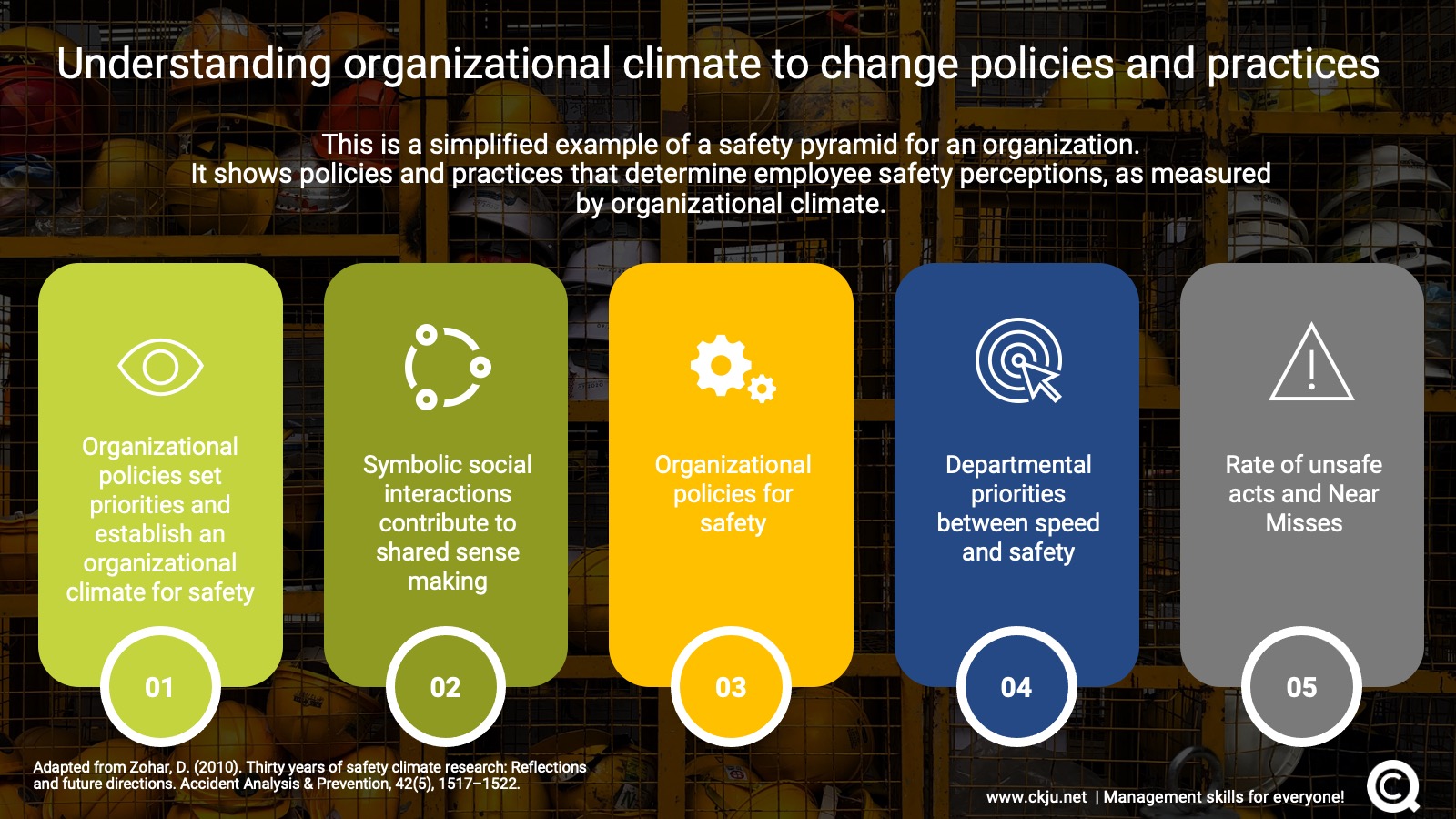- All Management Learning Resources
- organizational climate

Why should you care about organizational climate?
Organizational climate is a barometer for judging the employee sentiment about their employers’ policies and practices. By measuring the readings of this barometer, organizational policies and practices can be made more aligned with organizational goals and strategy.
Unlike organizational culture, which is a more fuzzy concept, organizational climate can be easily segregated into concrete categories with a direct relation to the measured outcomes (Parker et al., 2003). This flexibility makes it a vital variable for those in leadership positions, who can then measure the anticipated response for a new policy or change or even employee's responses to an existing policy’s measures.
Contents
- Why should you care about organizational climate?
- What is organizational climate?
- How can we measure organizational climate?
- What are the outcomes of organizational climate?
- How can we shape organizational climate?
- Critical appraisal of organizational climate: Solidity Rating 4
- Conclusion
- Key recommendations for professionals
- References and further reading
What is organizational climate?
Organizational climate is an construct referring to the shared meaning attached to an organization’s policies, practices, and measures that are associated with the employee experience (Schneider et al., 2013). The term has a lot in common with organizational culture, which denotes the shared meaning attached to the beliefs, assumptions, and values associated with how work is done and the norms that guide behaviour within the organization (Carvalho et al., 2019; Schein, 1991).
Organizational climate helps measure employee perceptions
However, unlike organizational culture, which is a combined response and understanding of “how things work around here”, the idea of organizational climate can capture the slice of response towards a specific policy, measure, change, or even a leader. This is why researchers usually focus on different levels of the organization when estimating climate.
Organizational climate helps assess safety
A good example are the studies into organizational safety climate affecting the way supervisors communicate and monitor safety behaviour which, in turn, affects the priorities set by the employees, their attitudes, and compliance (Curcuruto et al., 2018).
How can we measure organizational climate?
The measurement of organizational climate depends on its intended use. It can be assessed through surveys which measure inter-rater agreement for the construct when measured as a whole (James et al., 2008). However, it is suggested that it is better to restrict the construct’s measurement to a specific area which can be related to its direct outcomes (Svyantek & Bott, 2004).
One such example is measuring how strong organizational climate is in the domain of customer service, which yields a score through a longitudinal lens. This links positive customer service climate to higher customer satisfaction and higher financial performance for the organization (Schneider et al., 2009).
What are the outcomes of organizational climate?
The foremost area of research in organizational climate’s influence is safety as it predicts outcomes in all levels of the hierarchy. Zohar (2010) has suggested a safety pyramid linked to organizational climate which is adapted and simplified here:
Organizational climate sheds light on employee opinion and behaviour
Another aspect of organizational climate is its influence on the behaviour of employees with studies showing that negative climate causes adverse health impacts (Gershon et al., 2007) while a positive climate focussing on employee satisfaction, skill development, and welfare leads to higher company productivity (Patterson et al., 2004).
Positive organizational climate has benefits for the organization
A positive organizational climate also leads to higher leader efficacy which manifests in better employee retention, customer satisfaction, and revenue generation (Cooil et al., 2009). Therefore, organizational climate can be linked to both employee and organizational outcomes making it an important construct and tool for managers.
How can we shape organizational climate?
In one of the few studies that have explored this aspect, Grojean et al. (2004) suggest ten ways to shape and influence organizational climate:
- value-based leadership
- setting an example of desired behaviour
- establishing clear expectations
- setting aligned policies and practices
- forming formal socialization activities
- providing feedback, coaching, and support
- recognizing and rewarding behaviour that supports values
- recognizing individual differences in employees
- providing for personalities, and
- striving for inter-person congruence and person-environment fit.
Shaping organizational climate requires leadership interventions
These behaviours together work as leadership strategies for ethical organizational climate. Interventions that are aimed to improve leadership behaviours lead to improvement in the perception of organizational climate which, in turn, improves the organizational performance (Cuadra-Peralta et al., 2017).
More research is needed to understand influencing organizational climate
More studies are needed to assess ways for improving organizational climate, however, most researchers treat this construct as a measure and not a cause in its own right. Consequently, they explore the organizational climate with respect to a variable they wish to study, like safety or customer service, and use the results to report its impact on the employees.
Critical appraisal of organizational climate: Solidity Rating 4
The solidity rating for organizational climate is 4. There are some meta analytic studies available which have explored the impact of organizational climate on employee outcomes. Some of the gaps that remain in the empirical studies are about using the organizational climate for improving employee outcomes. Moreover, studies that link human resource policies and practices to organizational climate are also few. No metanalytic studies could be found that link organizational climate to practical measures. Finally, not many qualitative studies could be identified to understand how well managers and employees are able to grasp the concept and use it for improving their performance.
Conclusion
Organizational climate denotes the shared perception of employees towards the formal policies of their employer and informal practices of their leadership. The construct has several similarities with organizational culture but it has the potential to be a better barometer of employee response to an organizational policy or practice as it can be operationalised for a specific category.
Measures for assessing organizational climate as a whole, or for a specific practice area like safety and customer service, have been reported by researchers. However, few studies report how to improve organizational climate for better results.
Management skills newsletter
Join our monthly newsletter to receive management tips, tricks and insights directly into your inbox!
Key recommendations for professionals
- Organizational climate is a conceptual barometer used to measure employee sentiment
- Measuring organizational climate usually takes the form of surveys and can be applied to the organization as a whole, or to specific areas
- Understanding employee behavior and sentiment can help change policies and practices to help organizational outcomes
- Some areas lend themselves well to improving organizational climate: health & safety, and customer service
- There are ten broad techniques to influence organizational climate in an intended direction, however more research is needed to ground them
References and further reading
Carvalho, A. M., Sampaio, P., Rebentisch, E., Carvalho, J. Á., & Saraiva, P. (2019). Operational excellence, organisational culture and agility: The missing link? Total Quality Management & Business Excellence, 30(13–14), 1495–1514.
Cooil, B., Aksoy, L., Keiningham, T. L., & Maryott, K. M. (2009). The relationship of employee perceptions of organizational climate to business-unit outcomes: An MPLS approach. Journal of Service Research, 11(3), 277–294.
Cuadra-Peralta, A. A., Veloso-Besio, C., Iribaren, J., & Pinto, R. (2017). Intervention for supervisors, based on social skills and leadership, in order to improve organizational climate perception and organizational performance outcomes. Journal of Organizational Change Management.
Curcuruto, M., Griffin, M. A., Kandola, R., & Morgan, J. I. (2018). Multilevel safety climate in the UK rail industry: A cross validation of the Zohar and Luria MSC scale. Safety Science, 110, 183–194.
Gershon, R. R., Stone, P. W., Zeltser, M., Faucett, J., Macdavitt, K., & Chou, S.-S. (2007). Organizational climate and nurse health outcomes in the United States: A systematic review. Industrial Health, 45(5), 622–636.
Grojean, M. W., Resick, C. J., Dickson, M. W., & Smith, D. B. (2004). Leaders, values, and organizational climate: Examining leadership strategies for establishing an organizational climate regarding ethics. Journal of Business Ethics, 55(3), 223–241.
James, L. R., Choi, C. C., Ko, C.-H. E., McNeil, P. K., Minton, M. K., Wright, M. A., & Kim, K. (2008). Organizational and psychological climate: A review of theory and research. European Journal of Work and Organizational Psychology, 17(1), 5–32.
Parker, C. P., Baltes, B. B., Young, S. A., Huff, J. W., Altmann, R. A., Lacost, H. A., & Roberts, J. E. (2003). Relationships between psychological climate perceptions and work outcomes: A meta‐analytic review. Journal of Organizational Behavior: The International Journal of Industrial, Occupational and Organizational Psychology and Behavior, 24(4), 389–416.
Patterson, M., Warr, P., & West, M. (2004). Organizational climate and company productivity: The role of employee affect and employee level. Journal of Occupational and Organizational Psychology, 77(2), 193–216.
Schein, E. H. (1991). What is culture. Newbury Park, CA: Sage Publicatios, 243–253.
Schneider, B., Ehrhart, M. G., & Macey, W. H. (2013). Organizational climate and culture. Annual Review of Psychology, 64, 361–388.
Schneider, B., Macey, W. H., Lee, W. C., & Young, S. A. (2009). Organizational service climate drivers of the American Customer Satisfaction Index (ACSI) and financial and market performance. Journal of Service Research, 12(1), 3–14.
Svyantek, D. J., & Bott, J. P. (2004). Organizational culture and organizational climate measures: An integrative review.
Zohar, D. (2010). Thirty years of safety climate research: Reflections and future directions. Accident Analysis & Prevention, 42(5), 1517–1522.
About the Author




